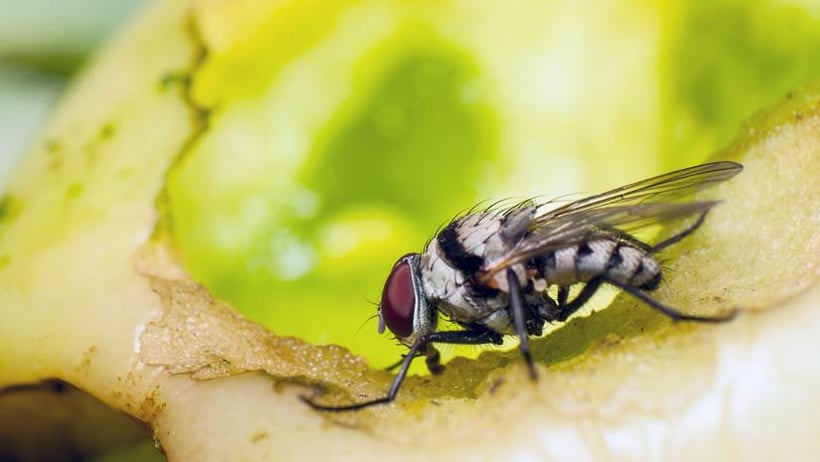
Anyone who has encountered swarms of flies in their workplace knows all too well how much of a problem these insects can present — especially if their business prepares, sells, or serves food!
Not only can flies easily find their way inside, but they also reproduce very quickly and present a health and safety issue by contaminating every surface they land on.
From the customer's perspective, flies are irritating and known to be filthy, all of which is bad news for any establishment that sells food.
Flies can be a big deal
Flies may be small, but they are damaging in significant ways. Flies can:
- Spread disease: Flies transfer pathogenic microorganisms, including bacteria that make people sick, simply by landing on food contact or preparation surfaces. Their bodies, eggs, faeces and vomit all play a part in flies’ ability to transfer more than 100 pathogens including E. coli, Salmonella and Shigella. Many of these diseases involve symptoms such as vomiting, stomach cramps, diarrhea, fever and dysentery.
- Contaminate food: When flies land on food, they immediately vomit on it — this allows them to dissolve and slurp up food, as they can’t chew. Flies’ stomachs contain anything from garbage to feces, germs, rotting meat and decayed organic matter, leading to food poisoning for your customers.
- Breed rapidly: A female housefly can produce 1,000 eggs in her roughly 28-day lifetime. It only takes 10 days for larvae to mature into adults. In short, flies reproduce at a rate that can become uncontrollable for a business.
- Hurt your reputation and bottom line: If you have flies in your establishment, you won’t have customers for long — no one wants to constantly swat pests away from themselves and their meal. Flies can damage your reputation, and cost money in lost revenue as well as fees associated with failed health inspections.
Identify any issues
You can likely identify an existing fly problem simply by seeing the insects buzzing around. However, you may also be able to predict an upcoming issue if you or an employee spot a cluster of larvae or eggs, which can be seen with the naked eye.
What do fly eggs and larvae look like?
- Housefly larvae (maggots) resemble small, white or pale worms
- Housefly eggs look like grains of white rice
- Housefly pupae are dark in colour with hard outer shells
Prevent flies’ entry with a few best practices
Flies are attracted to food, sugars in alcohol, garbage, scraps and to any area that promises a meal! Make your establishment unwelcoming to flies by following a few simple guidelines:
- Never leave waste or unused food lying around your business
- Keep dumpsters as far from the building as possible, and ensure you use leak-proof and pest-proof garbage containers
- Regularly clean and sanitize garbage containers and recycling bins
- Clean up food spills as soon as they happen
- Clean food contact equipment at least once per day
- Keep doors, windows and any other openings sealed shut
- Ensure alcohol containers are sealed; if alcohol bottles have spouts, cover them tightly with plastic when not in use
Your establishment is probably already following these rules, as they’re just good business practices. Boost your cleaning and sanitizing practices to keep flies and other pests away, and prevent food-borne illness.
Already have flies? Tackle the problem head-on
The three main tools used for getting rid of a fly infestation include:
- Fly spray: While effective for killing flies, sprays can easily cause chemical contamination of food if they’re used near open food or food preparation surfaces. This means you must only use fly sprays when the whole area is not in use (e.g. after closing) and move all utensils, equipment or food out of the way first. After spraying, clean and sanitize any equipment in the vicinity.
- Electrocutors: These attract flies, moths and other insects to the inside of the unit, and kill them with high-voltage electricity. The unit can’t hold many insects, though, so dead flies will often fall to the ground below. This makes it imperative to place electrocutors at least two metres from food preparation or storage areas, and empty them frequently.
- Fly strips: These attract flies to sticky paper that traps them, which you can then throw away. Replace fly strips frequently, and wash your hands thoroughly after handling them.
At the Canadian Institute of Food Safety (CIFS), we provide CIFS Members with a library stocked full of useful food safety resources, such as the CIFS Guide to Pest Prevention and Control, which explains ways to eradicate flies and other pests that present problems for a food business. Contact us to find out more about membership, or to enrol in the Official CIFS Food Handler Certification Course.
Frequently Asked Questions
What are the health risks associated with flies in food businesses beyond the contamination and diseases mentioned?
Beyond the common food contamination and disease transmission, flies in food businesses pose additional health risks that are often underestimated. Adult flies can carry a significant load of bacterial pathogens, including E.coli, Staphylococcus aureus and Salmonella, which they can transmit through bites or by contaminating surfaces with their saliva, feces and vomit. These pathogens can cause a range of illnesses from gastrointestinal infections to food poisoning and even skin infections.
Additionally, research has shown that fruit flies can spread disease-causing bacteria such as E. coli, Salmonella and Listeria from contaminated sources to fresh, ready-to-eat food. This highlights the importance of effective pest control in food handling establishments to prevent potential health risks.
The physical presence of flies can also be a vector for the transmission of viral and fungal organisms, potentially leading to diseases like hepatitis A, cholera, dysentery and rotavirus. Certain species of flies can even transmit the larvae of parasitic worms, which may lead to severe diseases such as river blindness and elephantiasis in extreme cases.
Understanding these risks highlights the need for the rigorous pest control as well as cleaning and sanitizing measures in order for food businesses to protect public health and comply with food safety regulations.
Are there specific examples of effective natural remedies or preventative measures that businesses have used successfully to deter flies?
Businesses are several natural remedies and preventative measures that businesses can use to deter flies effectively:
Essential Oil Sprays: Essential oils like lavender, lemongrass, peppermint and tea tree oil are known for their insect-repelling properties. These oils can be diluted with water and sprayed around entry points like doors and windows to keep flies at bay. A mixture that combines several of these oils can be particularly effective.
- Herbal and Plant-Based Deterrents: Certain plants are natural fly repellents. For example, basil, lavender and marigolds can deter flies when planted near entry points or used inside. Additionally, placing pots of these herbs in areas like kitchens and dining areas can help reduce the presence of flies.
- Vinegar and Dish Soap Traps: This simple yet effective method involves filling a dish with apple cider vinegar, adding a few drops of dish soap and placing it where flies are a problem. The vinegar attracts the flies, and the soap decreases the surface tension, causing the flies to drown when they land on the surface.
- Water-Filled Bags: Hanging clear plastic bags filled with water near entryways can disorient flies due to the way light refracts through the water, effectively deterring them from entering the area. This method is particularly useful during daylight hours.
- Natural Fly Papers: Making flypaper using non-toxic materials like corn syrup and brown paper can capture flies without the use of harsh chemicals. These can be hung in areas where flies frequently appear.
These methods are environmentally friendly and safe for use around food, making them ideal for businesses in the food service industry looking to manage fly problems without resorting to chemical pesticides.
How do different climates or seasons affect the prevalence of flies, and what additional steps should businesses in particularly susceptible regions take?
Climate and seasonal variations significantly influence the prevalence and behaviour of flies, affecting businesses differently depending on their geographical location. In warmer climates, flies tend to be more active year-round, leading to a consistent need for control measures. In contrast, cooler climates might see a surge in fly activity during the warmer months, requiring seasonal preparedness.
- Temperature and Fly Activity: Higher temperatures generally increase the metabolic rates and breeding cycles of flies, leading to more rapid population growth. This is particularly problematic in warmer regions or during hot seasons where businesses may experience intense fly activity (PLOS).
- Moisture and Rainfall: Flies thrive in moist environments, which are conducive to their breeding. Regions with high humidity or frequent rainfall might face more significant challenges with flies. Businesses in these areas should ensure effective water management and drainage to reduce breeding grounds (PLOS).
Preventative Measures for Susceptible Regions: - Enhanced Sanitation: Regular cleaning to remove food waste and other attractants is crucial. This includes securing trash bins and removing standing water.
Physical Barriers: Installing screens on windows and doors can help prevent flies from entering business premises. - Climate-Controlled Environments: Maintaining a cool, dry interior through air conditioning can deter fly infestations.
Regular Monitoring and Quick Response: Businesses should implement routine checks for signs of fly activity and address any issues immediately to prevent outbreaks.
Additionally, climate change is expected to alter the geographic distribution of flies by expanding their suitable habitats into new regions, potentially increasing the range and duration of fly activity periods. This calls for adaptive management strategies that consider future climate scenarios to effectively control fly populations and minimize their impact on businesses.




